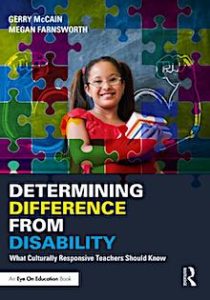Responding to Students’ Differences & Disabilities
Determining Difference from Disability: What Culturally Responsive Teachers Should Know
By Gerry McCain and Megan Farnsworth
(Routledge/Eye On Education, 2018 – Learn more)
Pre-service teachers in Assistant Professor Elizabeth Yomantas’ class at Pepperdine University are reviewing books for us this spring. Thanks to Dr. Yomantas for organizing this project!

Over the past year, as a university student who has come from a family of educators, I have become overwhelmingly passionate about the topic of culturally responsive classrooms.
Thus, I was eager to get my hands on Determining Difference from Disability: What Culturally Responsive Teachers Should Know and begin to learn more on the topic. I was very pleased with this book; its interactive nature and realistic examples made it a very enjoyable read with important implications.

I often tell her about what I’m learning and how she might apply it to her already successful career as a culturally responsive educator and children’s author. My desire to pick up the phone as I read this particular book shows the strong influential and impactful effect the writing holds.
Opportunities to reflect
Authors Gerry McCain and Megan Farnsworth begin with an introspective lens, encouraging teachers and educators to look within and address biases we may have. With interactive activities throughout the book, the reader is able to have meaningful engagements and reflections with the book’s lessons. This is something I found to be very useful as I read.
For example, in Chapter 1 the reader is encouraged to fill out a table entitled “Reflection Activity: Factors Influencing Teaching and Learning,” wherein the reader explores biases based on personal beliefs, and how those beliefs may cause them to marginalize groups of people. As a pre-service teacher, a student, and a human, I find it increasingly valuable to be introspective as a means to break down barriers of implicit and explicit biases.
The impact of culturally responsive teaching
As the book continues, the reader is able to see examples of how real students could be positively impacted by culturally responsive teaching and culturally relevant classrooms, complete with the challenges that intrinsic or extrinsic conditions may bring.
For example, Chapter 2 explores four students with linguistically and academically diverse abilities, as the authors suggest ways we might educate these students thoroughly and ethically. Again, with workbook-style activities, it is very simple to understand suggested steps to educate with the most benefit to the student.
McCain and Farnsworth do a fantastic job of highlighting resources educators have, such as cumulative files and surveys, that may be sent home to gain a fuller understanding of their students. I support their philosophy that it is important to normalize teacher-family communication in the modern classroom.
Working with diverse students with unique needs
Further, the book gives realistic classroom examples on both how to implement a culturally responsive pedagogy in classrooms, and how to do so with linguistically and culturally diverse students with unique needs. This includes comprehensive lesson plans geared toward realistic topics for grades K-5, which I found to be very helpful.
Additionally, this book contains several resources that readers are able to cross reference to previous chapters, including full IEPs (individualized education programs), as well as scoring forms, projects, analyses, support and education plans, and NLPs (or Native Language Proficiency, a plan for second language learners).
I praise this book greatly for its ability to display information in multiple ways for multiple types of adult learners. After all, teachers are learners, too. Having information in the form of paragraphs, tables, interactive activities, and figures is a two-fold advantage that allows the reader to have a full understanding of the material, while also displaying real examples of how to appeal to different learning styles in our educational journeys.
Other challenges students may face
Beyond cultural identities, the book describes the importance of focusing on the socio-emotional well being of students, as well as how it relates to disciplinary measures and behavior management. Importantly, the authors address the fact that many culturally and linguistically diverse students, otherwise known as CLDs, may face unique socio-emotional, socio-economic, and socio-cultural challenges due to a number of factors, such as recent life changes, political environments, anxieties, depression, and many others.
As educators, it is very important for us to understand the particular struggles of those around us. As much as we want to be understood by others, others want to be understood by us. Further, as a student and a human, it is a beautiful feeling to be heard and seen by those around you. At the core of this book, the authors articulate ways to ensure that the schooling experience includes a supportive and inclusive community for students.
Behavior management resources
McCain and Farnsworth suggest many behavior management resources that can be used in order to obtain a bigger picture of each students’ behavioral condition, such as data collection, peer mentors, and self-assessment by students, which is a personal favorite of mine. Being able to self-reflect, instead of solely being disciplined for behavior and thus feeling further misunderstood, is a great tool that can be implemented in our lives as teachers or parents.
As a college student in my university’s teacher education program, I found Determining Difference from Disability to be very beneficial to my line of study. I recommend this book to all teachers as well as all parents.
As a teacher, there are always ways to expand your moral and intellectual understanding of diversity in the classroom. Additionally, as parents it is equally impactful to understand how children may struggle in the classroom due to their unique and individual needs, so that parents are able to support their children the best they can.
From Camarillo, California, Kara Tyler is a third-year student at Pepperdine University in Malibu. Over the past 3 years she has been a part of the teacher education program at Pepperdine, as well as a student teacher for a second-grade classroom. Additionally, she has worked for Jumpstart, an organization which aims to teach children in underserved communities to read as a means to close America’s socio-economic literacy gap.



































Kara,
I want to thank you for such a positive and uplifting review of Determining Difference from Disability: What Culturally Responsive Teachers Should Know. It is always good to hear there is something in the text that students and teachers can benefit from. It was written with the intention to be a realistic guide or practical handbook for teachers working with a specific student population, and you captured that in your review.
Thank you again, and best of luck to you in your journey as an educator.
Gerry McCain